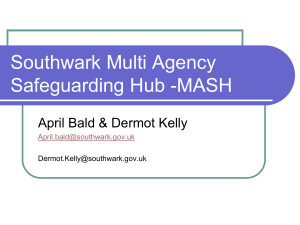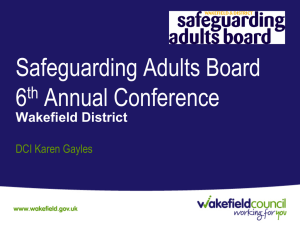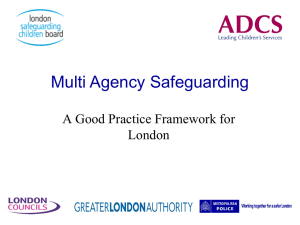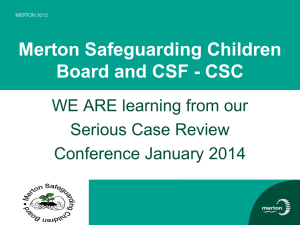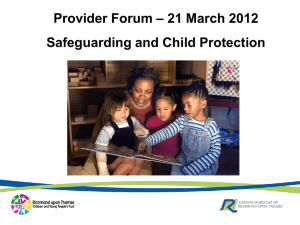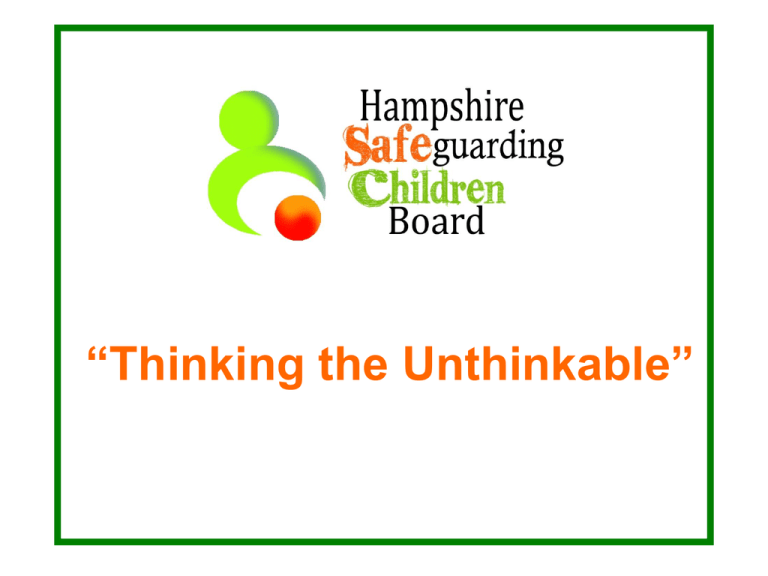
“Thinking the Unthinkable”
Housekeeping
•
•
•
•
•
Alarms
Toilets
Smoking
Breaks
Register
Aim
A conference organised by the Multi Agency
Safeguarding Forum North East designed to
challenge professionals in some of their
thinking about abuse.
Learning Outcomes
1. Getting professionals to challenge their own
thinking and avoid fixed thinking.
2. To consider how to develop professional curiosity.
3. To consider the need for appropriate challenge
4. To explore learning from serious case reviews
5. To raise awareness of joint working protocols
HSCB Priorities
• Embedding the HSCB Quality Assurance
Framework
• Ensuring compliance with the new Statutory
Safeguarding Guidance
• Safeguarding disabled children
• Tackling child sexual exploitation
• Young people who self harm
Programme
0900 – Arrival and registration
0930 – Welcome and administration - Lin Ferguson, Chair of MASF
0945 – Keynote speech – Professor Eileen Munro
1045 – Break
1115 - Joint Working Protocol - Bruising Protocol - Dr Simon Jones
1215 – Lunch
1300 – Case study exercise – Inspector Darren Murphy and Alison Nealis,
IRO
1430 – Break
1500 – Multi Agency Safeguarding Hub – Sarah Marston, District Manager
Childrens Services
1530 – Plenary session – Alison Nealis
1545 – Close
Break
Case Study exercise
Break
End
• Presentations will be sent out.
• Please complete the survey monkey
evaluation.
Have a safe journey home!
Improving reasoning in child protection
Eileen Munro
October 2014
Key message
•Improving reasoning is a shared
responsibility
Outline
You are human beings
Understanding how we use our intellect and
emotions
Being critical
You work with human beings
Importance of relationships
Challenges
Importance of organisational context
Understanding how we use our intellect and
our emotions
We have two processes for reasoning – intuitive and
analytic
Emotions play an essential, valuable, but sometimes
troublesome part
Intuition and analysis are on a continuum; we use
both to varying degrees in different tasks.
Intuition has persistent biases that need to be
consciously checked for by our analytic capacity.
The task determines the type of
reasoning needed
•The balance of intuitive and analytic reasoning
needed depends on the task you are doing.
•Some need a mainly intuitive approach; some
need a mainly analytic approach.
•Neither is ‘best’ is an absolute sense
Human reasoning
“System 2 [our analytic skill] is the supporting
character who thinks she is the hero. The
defining feature of system 2 is that its
operations are effortful and one of its main
characteristics is laziness. As a consequence,
the thoughts and actions it thinks it has chosen
are often guided by system 1 [intuition]”
Kahenmann, D. (2011) Thinking, Fast and Slow, London, Allen Lane
Analytic thinking as a personal
trainer
•Intuitive reasoning is the basic process that we
then improve by using analytic thinking to:
•articulate
•check (being aware of biases)
•test deliberately
Respectful uncertainty
Intellectually accurate but
Very uncomfortable
Workers need prompting and support to
question their assessment –hard to do on
own, however senior.
Being critical
Reluctance to change our minds
First impressions – anchoring
Using limited range of information
Attribution error
De-biasing
•The common element in all strategies is to
consider alternative perspectives:
– Thinking why your view might be wrong
– Devil’s advocate deliberately taking opposing
view
– Reducing attribution error by thinking about how
you might have behaved.
Supervision
•Where you help the worker articulate the reasons for
their intuitive judgments
– Stories can be good mechanism
•Help them consider their emotional responses
•Check for biases in their reasoning
•Consider how else to test judgments
•Consider relevant research
Articulating intuition: developing
the story
•Makes you think beyond the current snapshot:
stories have a flow
•What happened? Need description
•Why did it happen? Need analysis
•What might happen? Devise plan to reduce
Dealing with dissent
Culture of good manners can stifle dissent at
multi-agency conferences
Disagreement can feel like personal attack
and so gets hostile response
Need culture that allows people to query
judgments impersonally
You are working with human
beings
•You can deliver a pizza but you cannot deliver a child
welfare service. You need the ‘customer’ to be an
active agent in the production of the required outcomes.
Child welfare services simply fail if the intended
recipients are unwilling or unable to engage in a
constructive way; outcomes are co-produced by citizens.
•Adapted from Chapman J. (2004) System failure: why governments must learn to think differently,
London, Demos
Features of the Working Alliance
Family:
Agrees with worker on the tasks to work on
Agrees on goals
Develops an affective bond
Skilled workers
Challenges: emotions
Child maltreatment arouses strong feelings. We deal
with families expressing strong emotions of anger,
despair, fear.
Workers need support and critical reflective supervision
in managing the emotions or they distort reasoning
Challenges: handling ambivalence
•Families have strengths and dangers
•Holding both in mind as you work with them
is difficult
•Focusing on good OR bad alone distorts
understanding
Challenges: limited knowledge
•We have limited understanding of all aspects
of the work – causes, identification, responses
•In specific cases, we have limited knowledge of
what is going on.
•We need to value and support expertise and
professional judgment
Challenges: managing uncertainty
We want to ensure that all children are safe but
we can’t. There is too much uncertainty
Respecting this means that we stop talking of
‘ensuring’ all children are safe – aim to make them
SAFER
Challenge anyone who believes managing risk =
eliminating risk
A just culture not a blame culture
Need to develop shared features of making
decisions in uncertain conditions
Don’t set unrealistic goals of ‘ensuring’ all children
are safe
Defensive practice does not AVOID risk
but DISPLACES it, usually onto
children and families
When are rules desirable?
•Need central prescription of goals and professional duties
•Simple tasks – follow the rules, e.g. arranging payment for
foster carer
•Complicated tasks – needs professional skill in deciding what
the task is and how to perform it, e.g. does this referral warrant
a S47 investigation?
•Complex tasks – no complete solution is known but we seek to
minimise the problem, e.g. preventing child maltreatment
Supporting the workforce
Closer involvement with families has an emotional
dimension. Workers are exposed to the most intensely
painful of human emotions - fear, despair, anger,
sadness. Do they feel helped to handle this? If not,
they are more likely to show the features of burnout:
emotional exhaustion and compassion fatigue.
Emotional resilience in workers is associated with
feeling that they have a manageable workload and a
sense of personal accomplishment.
Organisational factors that discourage
good thinking
•A blame culture
•Risk management through defensive practice
•Very prescriptive procedures that discourage
creativity and flexibility
•Heavy caseload so little time to think
•Culture that devalues need for critical review
•No feedback on outcomes
Key points
We are all vulnerable to intuitive errors
of reasoning: they are a feature of being
human, not of being stupid.
We will make most progress if we think
of good reasoning as a shared
responsibility
Simon Jones
Consultant Paediatrician
07774741471
• Joint Working Protocol
• Bruising Protocol
• Personal reflections
Joint Working Protocol
Consider children of parents with
mental ill-health
substance misuse
learning disability
emotional or psychological distress
All Children (11 million)
280,150 children in Hampshire
Vulnerable Children (4 million)
Children in Need (400,000)
~ 10,000 children in
Hampshire
Children Looked After (60,000)
1,266 children in Hampshire
Child Protection Plan (29,000)
1,113 children in Hampshire
The Protection of Children in England
A Progress Report, Laming, March 2009
Joint Working Protocol
Consider children of parents with
mental ill-health
substance misuse
learning disability
emotional or psychological distress
Early help – secondary prevention
Not at level of significant harm
Joint Working Protocol
1999 following SCR
2004 – ‘Hidden Harm’
2008 – young people
2011 – parents with LD
2014
Joint Working Protocol
Record
Child’s name, dob, address, carer, school
Ask ? CSD / CPP / CAF / young carer
Discuss
Professionals involved, safeguarding lead
Refer
CSD for early help
or Drug/alcohol, LD, mental health services
Joint Working Protocol
Key messages
Hear the ‘voice’ of the child
Discuss concerns with the family
Know when to act immediately
Share information & update with new
concerns eg non-compliance
Stay involved
Joint Working Protocol
Sharing Information
Share with consent if appropriate
Seek advice, consider safety
Necessary, proportionate, relevant,
accurate, timely, secure (Data Prot Act)
Keep a record
Duty to share written into all legislation
GMC Guidance for Doctors
Importance of consent in most cases
Disclosure without consent justified if
Failure to disclose may expose patient or
others to risk of serious harm
3rd parties who are of direct relevance to
child protection eg adults who may pose
a risk to a child
Common law duty of confidence
Personal information should not generally be
disclosed without consent of the subject
Disclosure without consent justified in the
public interest to prevent harm to others
proportionate response
sanctioned by law (Art. 8 HRA)
go no further than necessary
Data Protection Act 1998
Necessary, proportionate, relevant,
accurate, timely, secure
Allows disclosure without consent
o Prevention or detection of crime
o Apprehension or prosecution of offenders
o Exercise of a statutory function eg s17/47
o Exercise or defend legal rights eg Art 3 (HRA)
Bruising Protocol
Bruising Protocol
Bruises in infants and toddlers ‘those who don't cruise rarely bruise’
Sugar NH, Taylor JA, Feldman KW. Arch Paediatr Adolesc Med 1999;153(3):399-403
Bruises are rare in babies not mobile
366 < 6 months
only 2 had bruises (0.6%)
973 < 36 months
none had bruises on hands or buttocks
Bruising Protocol
4 months of age
Bruising Protocol
o Raise awareness of significance of bruising in
NIM (non independently mobile) children
o Reflect lessons learned from SCR
o Encourage sharing of concerns
o Consistent with NICE guidance
o Guard against professional optimism
o Joint Health & Social Care 4LSCB-wide policy
Bruising Protocol
Individual Management Review (IMR)
20 days, bruise to right cheek
‘2y sibling threw a toy’
18 weeks, small bruise on forehead
‘hit with a teething ring’ by sibling
20 weeks, bruise under left eye
seen by GP, no action taken
21 weeks, bruises on face and abdomen,
seen by paediatrician, no action taken
26 weeks, fell out of chair, bruise to nose
referred to CSD
Health Practitioner observes bruise or suspicious mark
SUSPECT child maltreatment1
A child who is seriously ill should be referred immediately to hospital
Seek an explanation, examine and record accurately
Note any other features of abuse2 eg bruises on face and
‘soft’ areas, bruises in clusters or imprints
Explain to family the reason for immediate referral
to Children’s Services Department
and Consultant Paediatrician3
Immediate Phone Referral
to Children’s Services
Department
Immediate Phone Referral
to Duty Consultant
Paediatrician3
for multi-agency assessment
and information sharing
and child seen urgently for
further investigation to
exclude a medical condition
Inform GP and HV
Inform GP and HV
Follow
4LSCB
Procedures4
Personal Reflections
Personal Reflections
Personal Reflections
Dealing with uncertainty
Team work
Good communication
Personal Reflections
“At no point during her stay in hospital, did
any doctor speak to Victoria in a formal
attempt to find out what had happened to her,
either with or without the assistance of an
interpreter... in the end she died a slow, lonely
death – abandoned, unheard and unnoticed”
Lord Laming
Personal Reflections
“…these services knew little or
nothing more about Victoria at the
end of the process than they did
when she was first referred…”
Lord Laming
Personal Reflections
We ‘protect’ data, when we
could protect children
Personal Reflections
Keeping Children Safe
Investing for the future
Culture of openness
Changes in practice
“Think The Unthinkable”
MASF NE Training event 2014.
Think The Unthinkable
• Working together guidance ‘makes absolutely clear
the legal framework and the expectations on
different professionals’. This requires a major
rethink in those agencies who still believe that their
role in safeguarding stops with a referral to social care.
• the Government Guidance stresses two key principles:
• Safeguarding is everyone's responsibility, and
• Where professionals are concerned each and every
agency has a role to play in safeguarding and
protecting our children.
Think The Unthinkable
• When it comes to “organisation culture” there is a need to:
• Create a culture of listening to children ensuring there is
senior buy in to safeguarding and ensure accountability of
commissioned providers and contractors.
• Have a designated professional with sufficient time and
support (including supervision) to promote the welfare of
children. These professionals should recognise the needs of
children including rescue from possible abuse and neglect.
• Follow safe recruiting practices.
• Ensure all staff and volunteers are competent to safeguard
the welfare of children and that their practice is reviewed.
There should be a mandatory induction and procedures about
responding to concerns about a child’s welfare followed.
Think The Unthinkable
• Here are the key messages from WTSC 2013 …Are
these new messages?
• Child-centred practice
• Improving inter-agency working relationships to
support effective safeguarding practice
• More effective prevention and early help
• Better Assessments
• Strengthening accountabilities and creating learning
frameworks
• Supporting the development of professional’s
expertise and effective social work practice.
Think The Unthinkable
PROFESSIONAL COURAGE AND CURIOSITY
• The views and feelings of children are actually very difficult to ascertain.
• Professionals do not always listen to adults who tried to speak on behalf of
the child and who may have important Information to contribute.
• Parents and carers can easily prevent professionals from seeing and listening
to the child
• Professionals can be easily fooled with stories we want to believe are true
• Is it too difficult to explore thinking/develop and test hypotheses when
parents are present in meetings?
• Effective multi agency work does not just happen by accident. It needs to be
co-ordinated.
• Challenging parents (and colleagues) requires expertise, confidence, time and
a considerable amount of emotional energy
Think The Unthinkable
• Table exercises:
• We would like you read the case study on your
table, complete the tasks requested.
• Please feedback your table’s 3 practice principles
or “Golden Rules” to support practice which in
turn can improve professional curiosity and
professional courage.
Hampshire Multi Agency
Safeguarding Hub
MASH
• Hampshire Children’s Services
Department have developed a Multi
Agency Safeguarding Hub which
operates alongside Hantsdirect and
Children’s Reception Team.
• MASH became operational on
31/01/14
Referral Pathway to Children’s
Social Care Direct
Public
Social Care
Professionals
Line
Hantsdirect
Children’s Reception Team
Embedded Social Work Team
Signposted
R&A
Partners involved in MASH
• Children’s Services inclusive of
education and YOT
• Police
• Adult Social care
• Health
Virtual Partners
•
•
•
•
Probation
Housing
District Councils
Hampshire Fire and Rescue
Service
• Hampshire Ambulance Service
MASH
CYP triage
CA12
Children
Social Care
& Education
Health
Adult
Services
Police
Virtual
Hampshire
Probation
Hampshire
Fire /
Rescue
Hampshire
Ambulance
service
Housing
Borough
and District
Councils
Community
Safety
Troubled
Families
Benefits of MASH
• A faster, more co-ordinated and consistent
response to safeguarding concerns about vulnerable
children and adults.
• An improved ‘journey’ for the child or adult with a
greater emphasis on early intervention and better
informed services provided at the right time.
• A more straightforward and responsive process for
the professional or customer raising a concern
• Closer partnership working, clear accountability and
improved multi-agency communications.
• A reduction in the number of inappropriate referrals
and re-referrals leading to effective targeting of
services
Benefits continued
• Avoids duplication and silo working.
• Staff and agencies have an increased
understanding and appreciation of each
others roles and responsibilities leading to
increased skills, better multi agency working
and more effective judgement.
• Development of flexible working patterns and
providing enhanced customer service.
Workflow April – June 2014
Hampshire
•
•
•
•
•
17743 contacts managed by CRT
5723 referrals through MASH
401 Section 47
2778 C&F Assessments
186 referrals stepped down to Early
Help
Current Position
• MASH service has been operational for 8
months.
• Service to Hampshire and Isle of Wight
• Face to face strategy discussions are working
well.
• CP referrals are managed within 2 hours.
• Children in Need referrals managed within 24
hours
• Good support from Early help to improve Step
down
Current Position
• CRT using SERAF tool to screen for
sexual exploitation
• Domestic Violence (Claire’s Law) and
Sex Offenders (Sarah’s Law) Disclosure
Service managed through CRT/MASH
• Temporary Child Protection Plans held
within CRT for HCC and IOW
• Social workers on MASH now work
shifts
Next Steps
• Potential for Probation to work from
MASH once per week
• YOT trial of workers in MASH
• Police are recruiting extra officers and
Staff
• Health have increased resources
• Work commenced to increase
involvement of virtual partners.
Questions?

